* (restored/expanded)
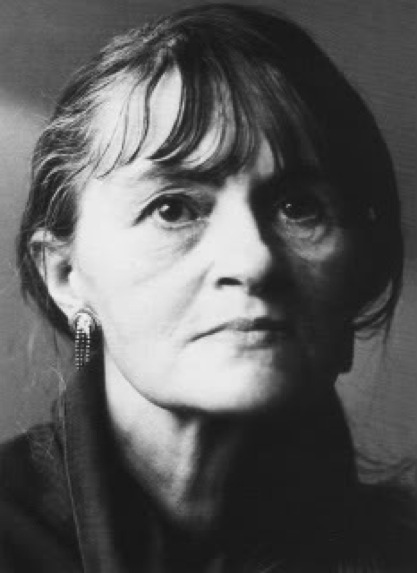
‘From my earliest childhood, the first woman’s eyes I encountered conveyed the same uncontrollable anguish spiders cause me…This is why I very soon divided myself into two halves.’ — Unica Zurn
Gary Indiana: A Stone for Unica Zürn
Unica Zürn has long been a semi-mythical figure. Little known and in many ways unknowable, she is inevitably associated with the Surrealist artist Hans Bellmer, whom she met at a Berlin show of his work in 1953. Obsessed throughout his career with realistic female dolls whose body parts could be endlessly manipulated, penetrated, removed, multiplied, decorated and otherwise reconfigured to posit flesh and bone as the material of a recombinative fetishism, Bellmer had worked and lived with other women before Zürn. (He’d also been married, and had fathered twin daughters.) But upon meeting Zürn he declared, ominously enough, “Here is the doll.”
From that moment on, their fates were intertwined—or, one could say, Unica Zürn’s fate was sealed. She was 37, Bellmer 51, when she moved to Paris to share Bellmer’s two rooms in the Hotel de l’Espérance, 88 rue Mouffetard. There the pair embarked on their own special variation on the Surrealist amour fou. They have been described as companions in misery who inspired each other. No doubt this is true. Zürn’s life before meeting Bellmer was troubled, to say the least. Born in 1916, she grew up in Grünewald, the daughter of an adored but mostly absent father, a cavalry officer posted to Africa, and his third wife, whom she detested. During the Nazi period, Zürn worked as a dramaturge at UFA, the German film company, married a much older man in 1942, bore two children and lost custody of them in a divorce seven years later; she then made a meager living writing short stories for newspapers and radio plays.
She also painted and made drawings in the late ’40s and early ’50s, independently lighting upon the Surrealist technique of decalcomania. Malcolm Green, in his introduction to the English version of Zürn’s novel The Man of Jasmine (Gallimard, Paris, 1971; English translation Atlas Press, London, 1977), describes this period of Zürn’s life as “happy.” She reestablished contact with former UFA colleagues, had what may have been an amiable social life, and enjoyed the work she did as a writer and artist.
One has to wonder, though only to wonder, how much of Zürn’s life transpired above the threshold of the dissociative states and debilitating depressions that later entrapped her. The writings for which she is best known reflect an excruciating mental state, relieved solely by fantasies and hallucinations; reality, in her description, is unbearably harsh and punitive, a realm of grotesquerie in which, she writes in Dark Spring (Merlin, Hamburg, 1969; English translation Exact Change, Cambridge, Mass.,2000), she is “mocked, derided and humiliated.” And while the narrator of that autobiographical novel avers that “pain and suffering bring her pleasure,” Zürn’s inner torment led many times to long spells in mental hospitals, and finally to suicide by throwing herself from Bellmer’s sixth-floor window in 1970, when she was 54.
____________
Hans Bellmer’s photographs of Unica Zürn
‘Hans Bellmer and Unica Zurn’s love affair began innocently enough at an opening featuring Bellmer’s surreal, life-size female dolls at Maison de France in Berlin (1953), attended by Zürn. Here, it was love at first sight, and Zürn wound up abandoning her writing career at UFA (the German state movie studio), to move to Paris with Bellmer in 1954. The couple became co-conspirators in overt sadomasochistic eroticism involving a third-party “surrealist doll,” documenting the actions by way of photographs, drawings, and writing.
‘First came Bellmer’s bondage drawings—what he called “altered landscapes” of the human body—with ropes cutting deeply into female flesh. These fantasies dated back to 1946, but it wasn’t until 1954 – 58, when Zürn took on the role of the willingly submissive model, that Bellmer made a series of uncanny photographs reproducing the earlier drawings.’ — Valery Oisteanu


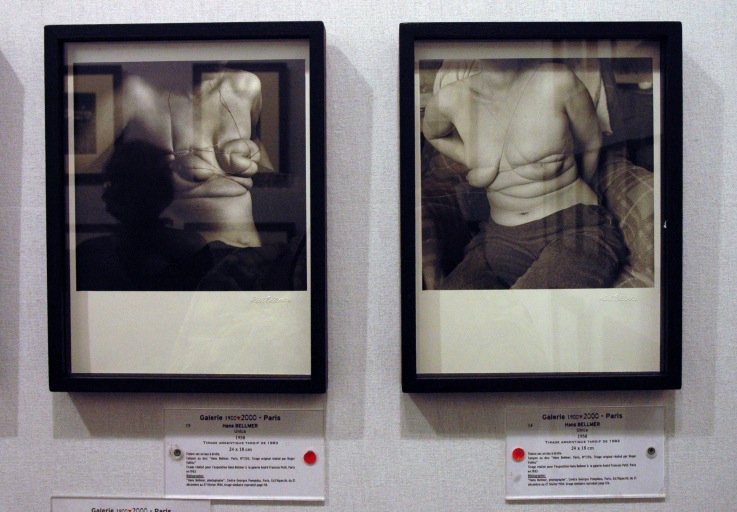

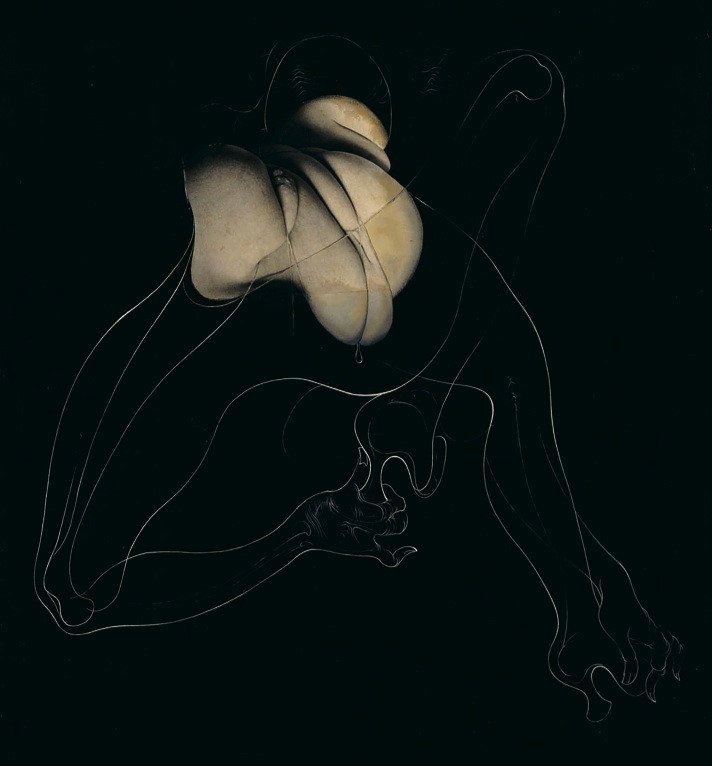
____________

‘Dark Spring is an autobiographical coming-of-age novel that reads more like an exorcism than a memoir. In it author Unica Zürn traces the roots to her obsessions: the exotic father she idealized, the “impure” mother she detested, the masochistic fantasies and onanistic rituals which she said described “the erotic life of a little girl based on my own childhood.”
‘Dark Spring is the story of a young girl’s simultaneous introduction to sexuality and mental illness, revealing a different aspect of the “mad love” so romanticized by the (predominantly male) Surrealists. Zurn committed suicide in 1970 — an act foretold in this, her last completed work.’ — Exact Change
Excerpts:
Each time, she finds herself tormented by her terrible fear of the rattling skeleton of a huge gorilla, which she believes inhabits the house at night. The sole purpose of his existence is to strangle her to death. In passing, she looks, as she does every night, at the large Rubens painting depicting “The Rape of the Sabine Women.” These two naked, rotund women remind her of her mother and fill her with loathing. But she adores the two dark, handsome robbers, who lift the women onto their rearing horses. She implores them to protect her from the gorilla. She idolizes a whole series of fictional heroes who return her gaze from the old, dark paintings that hang throughout the house. One of them reminds her of Douglas Fairbanks, whom she adored as a pirate and as the “Thief of Baghdad” in the movie theater at school. She is sorry she must be a girl. She wants to be a man, in his prime, with a black beard and flaming black eyes. But she is only a little girl whose body is bathed in sweat from fear of discovering the terrible gorilla in her room, under her bed. She is tortured by fears of the invisible.
Who knows whether or not the skeleton will crawl up the twines of ivy that grow on the wall below her window, and then slip into her room. His mass of hard and pointed bones will simply crush her inside her bed. Her fear turns into a catastrophe when she accidentally bumps into the sabers, which fall off the wall with a clatter in the dark. She runs to her room as fast as she can and slams the door shut behind her. She turns the key and bolts the door. One again, she has come out of this alive. Who knows what will happen tomorrow night?
*
It is a very beautiful day. The woman looks around and thinks: “there cannot ever have been a spring more beautiful than this. I did not know until now that clouds could be like this. I did not know that the sky is the sea and that clouds are the souls of happy ships, sunk long ago. I did not know that the wind could be tender, like hands as they caress – what did I know – until now?
She wants to look beautiful after she is dead. she wants people to admire her. Never has there been a more beautiful dead child.
She steps onto the windowsill, holds herself fast to the cord of the shutter, and examines her shadowlike reflection in the mirror one last time. She finds herself lovely. A trace of regret mingles with her determination. ‘It’s over,’ she says quietly, and falls dead already, even before her feet leave the windowsill.
_______________
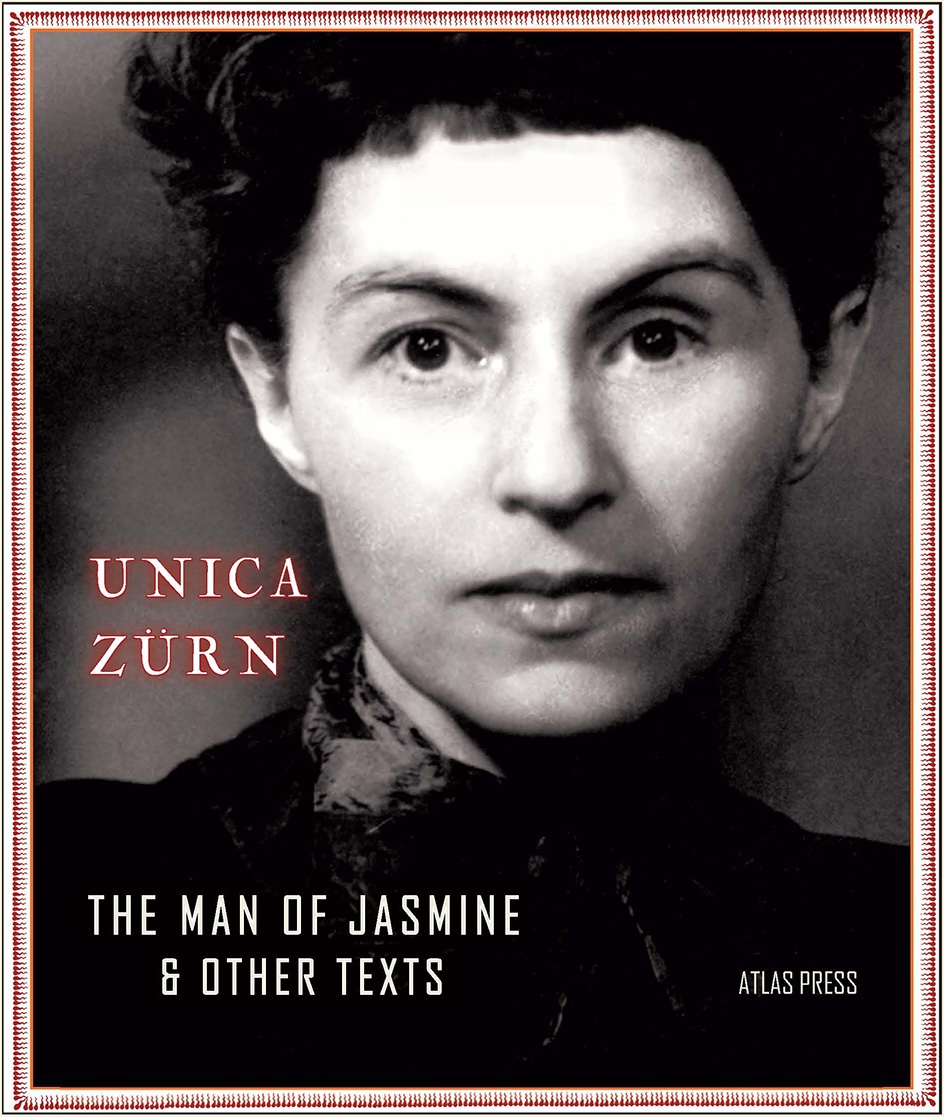
‘In the 25 years since Atlas Press first published The Man of Jasmine by Unica Zürn (1916–70) of her long history of mental crises, she has come to be recognized as a great artist at least the equal of her partner, the Surrealist Hans Bellmer. Yet her work is barely comprehensible without the texts printed here―now revised by translator Malcolm Green―in which she demonstrates how Surrealist conceptions of the psyche allowed her to welcome the most alarming experiences as offering access to an inner existence that was the vital source for her artistic output. Green’s introduction to this volume was the first study to consider her life and work from this perspective.
‘Zürn’s first mental collapse was initiated when she encountered her fantasy figure, “the Man of Jasmine,” in the person of the writer and artist Henri Michaux. This meeting plunged her into a hallucinatory world in which visions of her desires, anxieties and events from her unresolved past overwhelmed her present life. Her greatest works were produced during times of mental crisis, often when confined in asylums, and she tended to encourage the onset of these crises in order to provoke intense creativity. Her description of these episodes reveals how language itself was part of the divinatory method that could aid her recovery or predict a new crisis. Her compulsion for composing anagrams allowed her to release from everyday language an astonishing flood of messages, threats and evocations. This method, and Zürn’s eloquent yet direct style, make this book a literary masterpiece, while providing a rare insight into extreme psychological states.’ — Atlas Press
Excerpts:
One day at Wittenau the head doctor had called her to a room in which a group of students and psychologists from other clinics was assembled, and asked her to comment on her drawings as he showed them to the others. The drawing Recontre avec Monsieur M (ma morte) prompted a discussion, and she was asked: ‘Why did you cover the entire surface of the paper right to the edges? On the others you’ve left the space around the motif white.’
And she had answered: “Simply because I couldn’t stop working on this drawing, or didn’t want to, for I experienced endless pleasure while working on it. I wanted the drawing to continue beyond the edge of the paper – on to infinity…
*
Large shapes — like wings — float up to her, opening and closing — gently at first — until they slowly fill the room and she has the impression that she is in the presence of apparitions which are not at all related to this world. None of her acquaintances has ever mentioned similar apparitions to her. These beings — she can not describe them in any other way, reveal that they have the clear and frightening intention of encircling her. They exude a feeling of dissipation, of annihilation, and her forgotten childhood fear of the horrible and inexplicable returns to her. Whenever these birdless, greyish-black wings fly up too close to her, she raises her hand in a sudden anxiety and fends them off. They retreat for a moment into the background of the dark room, then approach once again, and slowly she gets used to this strange presence until she notices that the wings are insubstantial and can fly straight through her upright body, as if she herself had become bodiless. This both entrances and appalls her. Looking at them carefully, these creatures have in fact nothing terrifying about them — they lack eyes and faces, and they radiate an enormous dignity, an uncanny seriousness, something very noble.
______________
A Movie for Unica Zürn
Unica Zürn – Surrealism, Trauma, Resistance
Benoît Lepecq Lamenti, unica zürn / Hans Bellmer
Unica ZÜRN – Une Vie, une Œuvre : 1916-1970 (France Culture, 2007)
____________
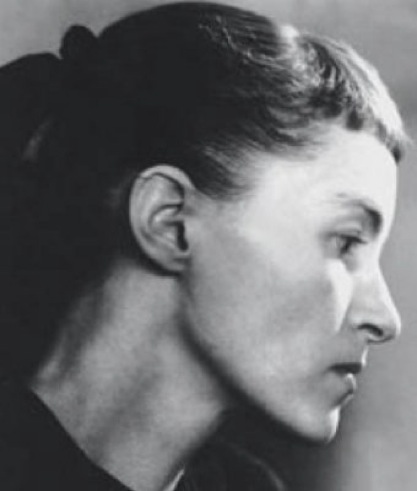
5 anagrammatic poems
AND IF THEY HAVE NOT DIED
I am yours, otherwise it escapes and
wipes us into death. Sing, burn
Sun, don’t die, sing, turn and
born, to turn and into Nothing is
never. The gone creates sense – or
not died have they and when
and when dead – they are not.
for H.B.Berlin 1956
DANS L’ATTELAGE D’UN AUTRE AGE
(Line from a poem by Henri Michaux)
Eyes, days, door, the old country.
Eagle eyes, a thousand days old.
Ermenonville 1957
WILL I MEET YOU SOMETIME?
After three ways in the rain image
when waking your counterimage: he,
the magician. Angels weave you in
the dragonbody. Rings in the way,
long in the rain I become yours.
Ermenonville 1959
HEXENTEXTE
I spread the white nothing
alas, white is nothing. Remorse
of white smoke stabs silk
of lenity. Sweetness is like
the white. Shout: Don’t do it!
She is me! Become sweet night!
WE LOVE DEATH
Red Thread’s body,
Turn bread in sorrow,
Not in question, ax is
Life. We, your death,
you weave your Lot
in soil. Game messenger
we love death
Berlin 1953/4
____________

18 drawings
‘Zurn had been a writer before she met the Surrealist photographer Hans Bellmer in Berlin in 1953 and moved with him, that same year, to Paris, where she became part of a circle that included Man Ray, Andre Breton, Max Ernst, and others, and was introduced to “automatic drawing.” This technique was originally designed to bypass the “rational” through a passive, “nondirected” engagement of the unconscious. Successive Surrealists made the method their own developing more active approaches corresponding with a variety of quasi-ideological strategies. Zurn, for instance, adapted a technique by which natural imperfections of paper are joined together to initiate the compositional field, instead introducing her own originary marks in the form of small sketched eyes, the basic motif of many of her later works.
‘Zurn was attracted to constraints, whether in the procedural rules of the anagram poems or in the conceptual decision undergirding the drawings never to allow figuration to arrive at coherent representation. Although her compositional strategies changed considerably over the years, Zurn’s hand remained remarkably consistent. She drew phantasmagoric creatures, chimerical beasts with transparent organs and multiple appendages, plantlike abstractions, oneiric forms, amoebic shapes whose fractal membranes are filled in with multiple recurring motifs: spirals, scales, eyes, dots, beaks, claws, conical tails, leaflike indents. Some early and late drawings are sketches, loose, spare, and barely formed, containing multiple, differentiated, quasi-representational figures; others, often on larger paper, have a more “finished” quality, offering a clear inside to the entity, and an outside expanse of unmarked paper. Zurn’s work shadows Surrealism’s last days. In its procedural simplicity and fragile materiality, it is also a curious outlier to emerging trends in art of the time.’ — Bartholomew Ryan, Artforum

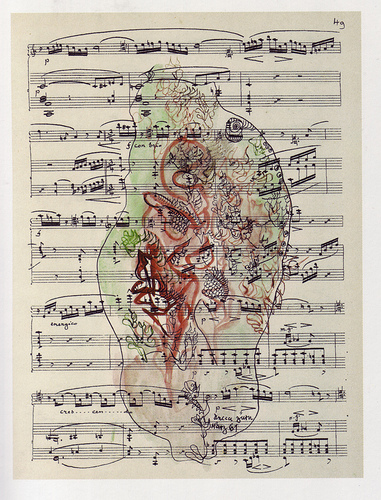
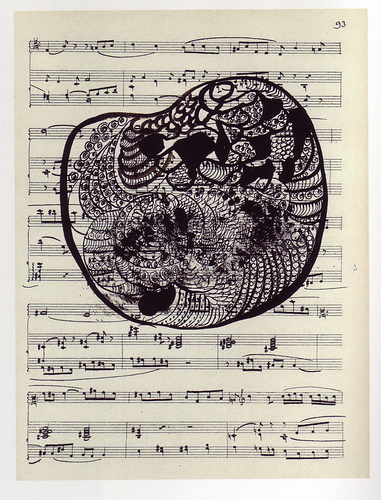
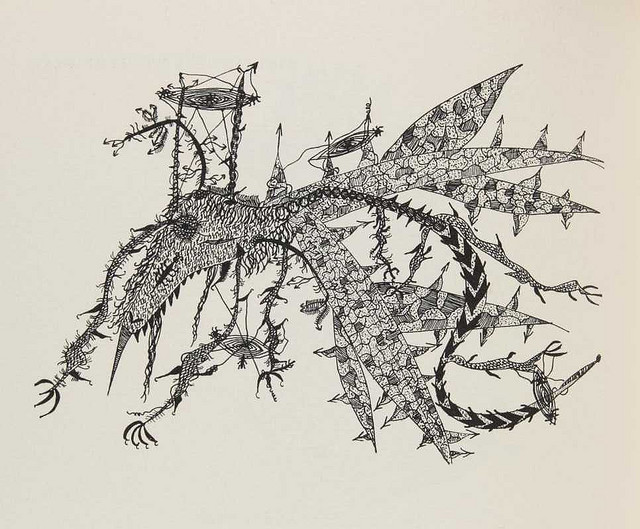
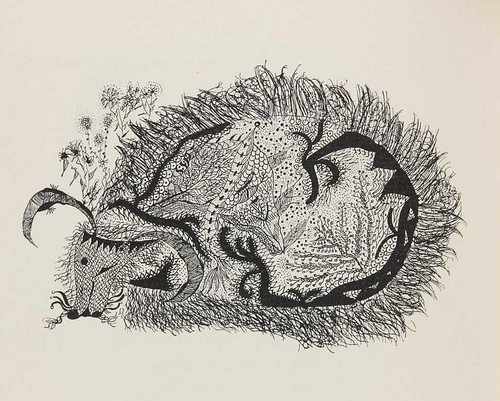
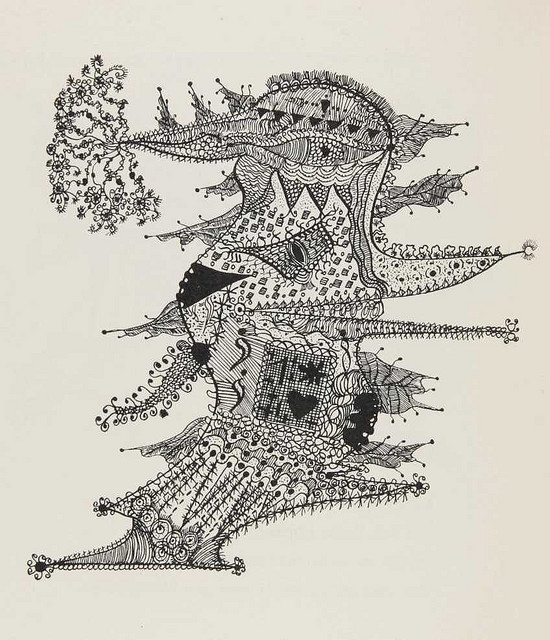

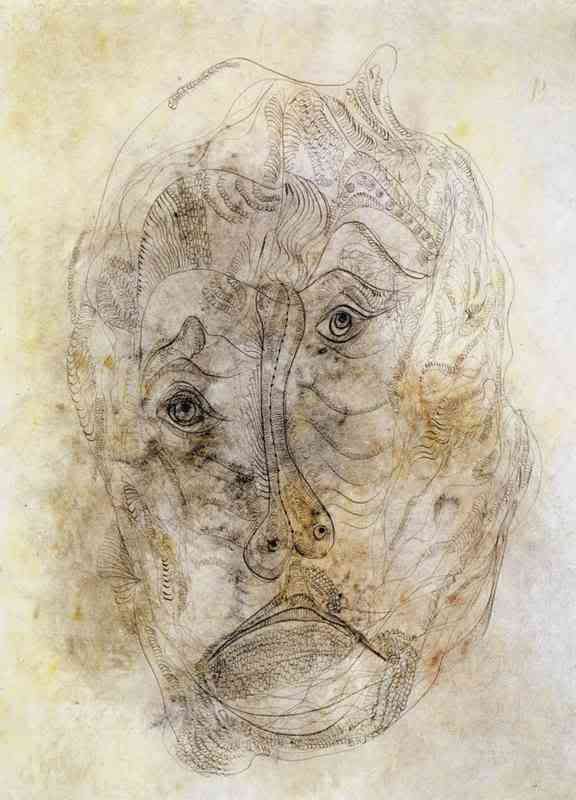

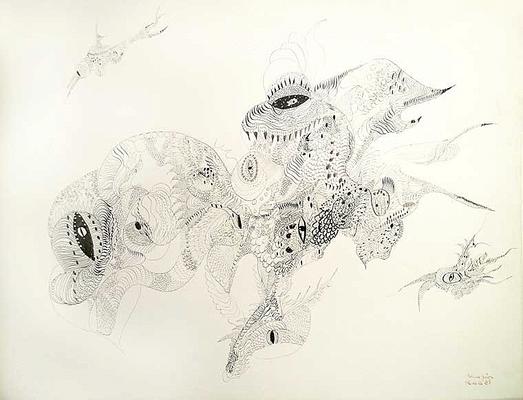
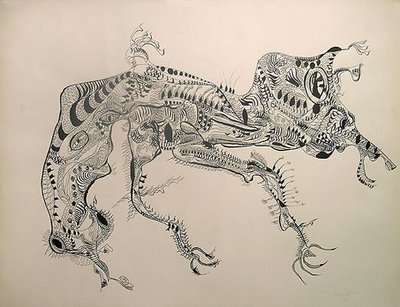
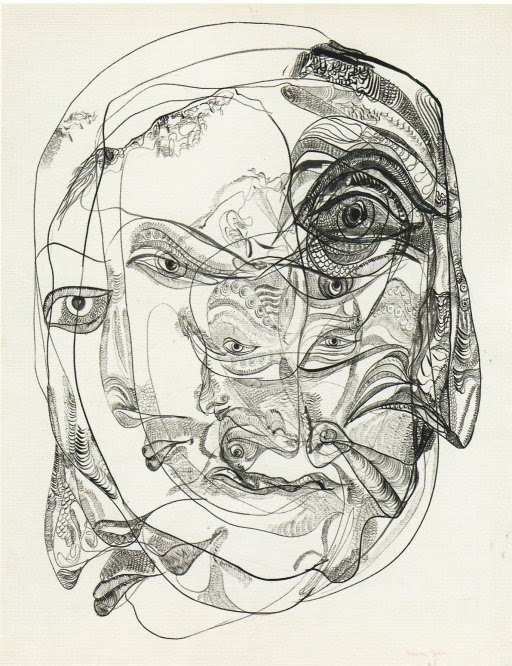
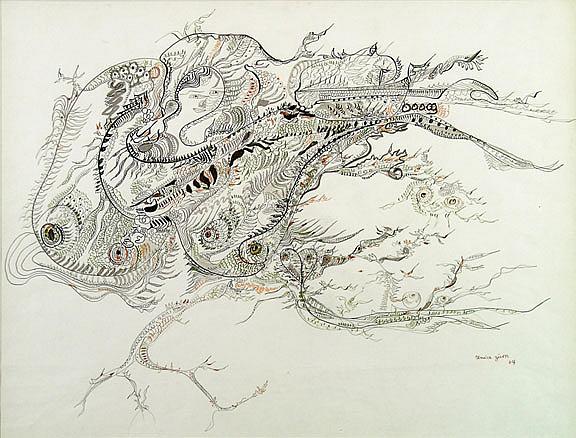
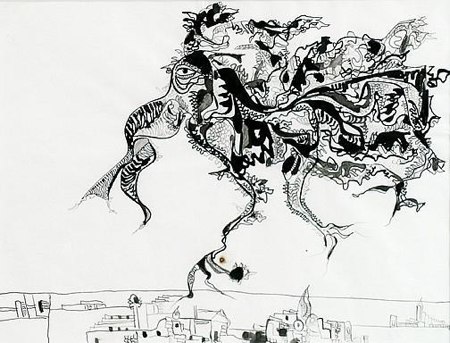
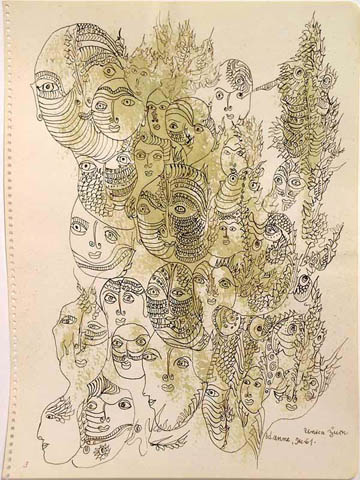

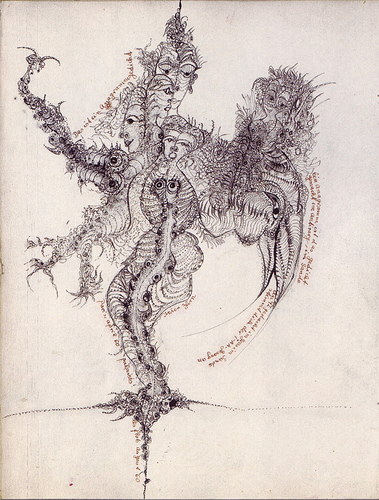
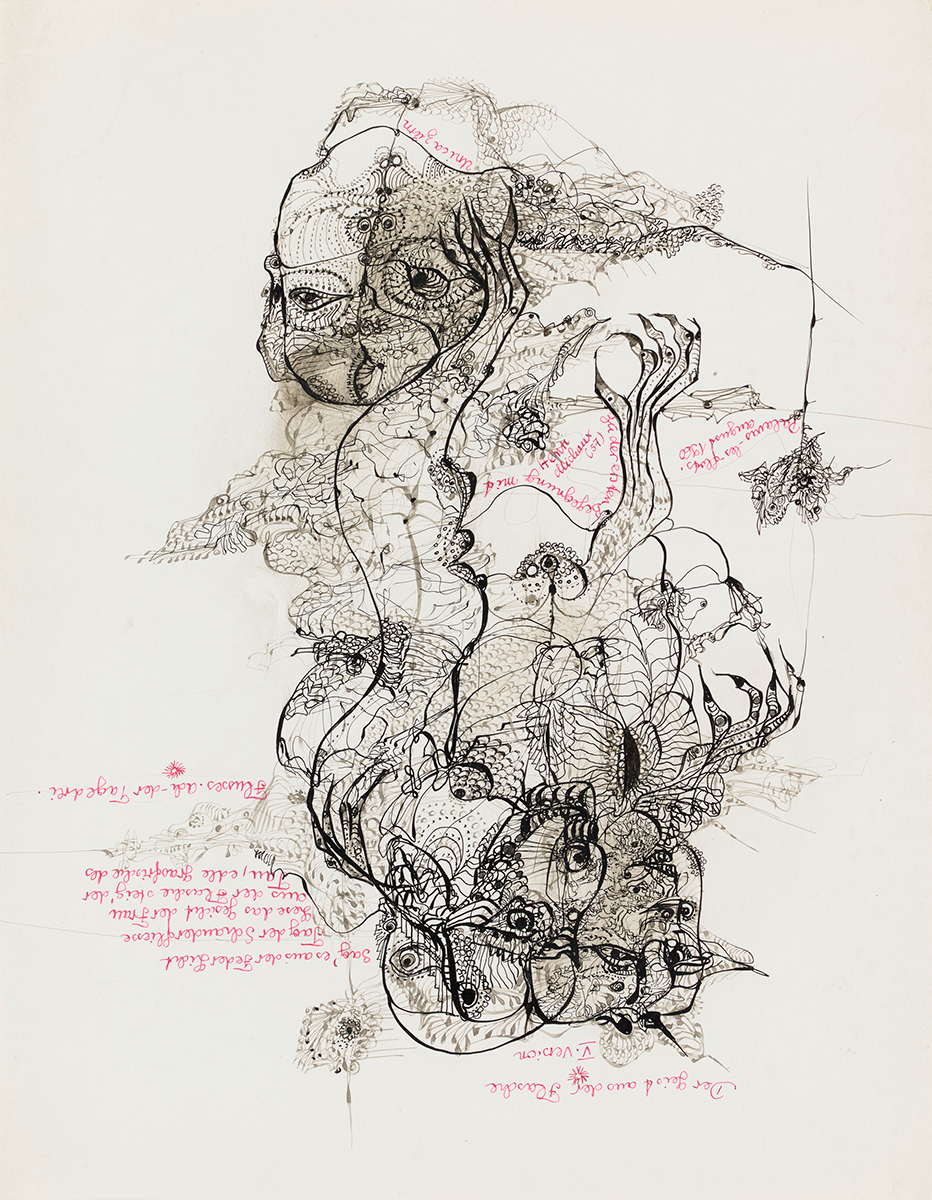
_______________

___________
Tributes
UnicaZürn, the band
Unica Zürn @ A Journey Round My Skull
Fantasies Embodied @ Tomorrow Museum
Unica Zürn et son MistAKE
Glass Trees ‘Songs for Unica’
Video: A MOVIE FOR UNICA ZÜRN
Video: Something Lives Inside the Machine
Unica Zürn Memory Page
‘Dark Spring’ Page @ Facebook
*
p.s. Hey. ** Dominik, Hi!!! Cool. ‘Wojaczek’ is one of my favorites of his. No, the German festival isn’t giving us extra time so we need an answer from the bigger festival by Friday or we’ll need to choose. This festival competition stuff is so annoying. Zac saw a rough draft of the trailer, and he said it’s not bad so far. No poster sighting yet, but they said they’re looking at the ‘Beetlejuice’ poster as a model, and that’s really not promising (to us). I have a little handheld vacuum cleaner that I mostly use to swallow up mosquitoes (RIP), so I feel you. Love craving a big, chewy chocolate chip cookie fresh out of its oven, G. ** jay, Hi, jay. Ah, you know his films, nice. You’re in Hungary? I didn’t realise that. Like in Budapest? That’s kind of the only thing in Hungary that I know of. Wow, I want to visit there. Never have been. Dominik’s originally from there, as you probably know. Save your emo clothes. They’ll be worth a fortune someday, mark my words. Enjoy everything. I’m going to spend my day being daydreamy. ** tomk, Hi, Tom. Both your comments made it. Big up to you bud. ** _Black_Acrylic, Shit, did my eyes somehow slip-slide over your comment yesterday? My sincere apologies if so. Okay, a plus in the ‘Weapons’ column, thank you. It’s starting to seem more doable. ** Steeqhen, Well, good news obviously. I was thinking something like that might be the case. That anything can produce an epiphany is one of the reasons why being alive so fucking rocks. ** Charalampos, Hi. The Kluge is very Kluge. Kind of a poetic essay film with a mix of altered found footage and fiction and staged reality. It’s just gorgeous and super intelligent like his films so often are. Every day is strangely the same. Best not to think about that too much probably. Devil horns from you-know-where. ** HaRpEr //, Thank you. I obviously love your idea about the protagonist’s bedroom and really look forward to your realisation. I like some of Barker’s later films too. Unfortunately his fiction just got worse and worse. ‘Books of Blood’, i.e. his earliest fiction, is so extremely his best. ** Bill, Hi. Too bad about the Joel Lane, but at least it’s not cancelled. New Joy Williams? Wow, she’s become almost prolific in her late years. Very exciting news, that. ** Steve, Okay, understood, so I was kind of right but not entirely in thinking it was menopause-specific. Hope you hear from the doc soon. Yes, the festival thing is maddening. I’m basically hoping that the bigger festival just says no at this point. It would make things much easier. If the bigger festival says yes for the ‘International Premiere’, we would lose three ‘smaller’ European festivals that have either said yes or are likely to because they occur before the bigger festival. That just seems very counterproductive to me especially since being in the bigger festival doesn’t mean anything special would happen for the film. But producers are so locked into the festival hierarchy thing that they don’t think things through clearly, in my opinion. Anyway, yes, obviously, very frustrating. I think Randy Newman said no because he doesn’t like doing interviews, and it was to be for the LA Weekly, and I don’t think or he or else his handlers thought that was enough. ** Dev, Nope, you were totally in time. Funny about the Boston food letdown. I’ve only been there a couple of times, and I didn’t get what was interesting about the place. Maybe it was the food problem. Never been to Charleston, but it does sound dreamy, at least when I shut politics out of my head. Nice. ** Corey, Colab sounds familiar, but I don’t think I saw their work unless I’m spacing. Thank you for the links. I’ll go investigate them. And I’ll definitely look into Andrea Callard’s films. Great, thanks a lot! Nice about the US trip. Zac and I were planning to be in LA in October/Halloween, but now we may have to stay over here for the festival stuff, grr-ish. ** Carsten, I see you. Great, pal, thanks so much! ** Okay. Today I have decided to restore and spruce up a long-lost past blog post dedicated to the great Unica Zürn. It should tide you over until tomorrow, I hope. See you then.
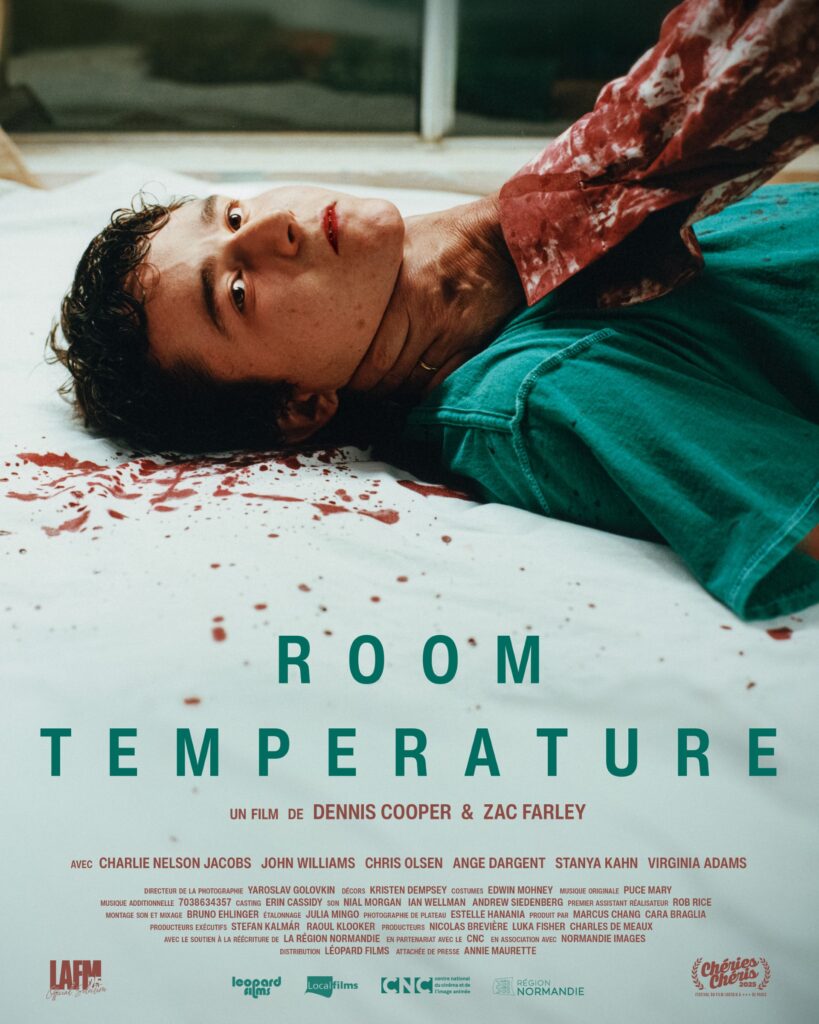



 Now available in North America
Now available in North America 
Yes! I’m a big Hans Bellmer fan, so this is a great day for me, haha. Her own work is amazing too – here’s a copy of Dark Spring, if anyone’s curious. That section is so good at describing early sexual fantasy, in terms of the weird reconfiguring of contextless images and symbols into unreal dynamics and anxieties. Speaking of books from children’s POVs, could you remind me of the name of that book you really like, that’s called “Diary of […], aged 12”, or something like that? No problem if you can’t remember.
Yes, I am in Budapest, haha. It’s not really a holiday, it’s more just going through my dad’s affairs so me and my sister can sell the flat. I’m in the 3rd district of Budapest at the moment too, so it’s a lot less beautiful European architecture and a lot more, like, Soviet tower blocks – not that one of those is better than the other, but one is certainly more holiday-ish. There are other parts of Hungary that are even nicer than Budapest, I think, there’s a giant lake called Balaton where I went on a holiday camp once that I remember being incredibly nice.
I will most definitely save my emo clothes, haha. I don’t think I could ever sell them, they’re in awful shape, but there’s something really fun about seeing the super musty Black Parade hoodie that used to be my uniform. So yeah, I’m mostly taking back my old emo kit, and probably my old Nintendo, just for nostalgia. I actually kind of need to knuckle down on sorting out the flat, given that I’m flying back on Friday and I still have a whole bookshelf to take to charity shops. There are also a ton of Thomas Mann books I want to take back with me, if I manage to compress my suitcase enough. Hope you’re good, see you round!
P.S. tomk, No problem, hopefully you and your friend enjoyed the interview!
I was majorly into UZ’s work back in the day and even wrote a Yuck ‘n Yum article in my first flush of excitement over that. Unfortunately the YNY website is currently down but I’m hoping it will be restored before too long. I never did catch the Trumpets of Jericho and will do so very soon.
Hi!!
There are certain artists I feel a deep, very personal pull toward the moment I first encounter them – their work, yes, but even photos of them – and Unica Zürn is one of them. It’s wonderful to see her showcased here today. Thank you!
I don’t have much to compare it to yet within Lech Majewski’s oeuvre, but “Wojaczek” is indeed remarkable.
Oh, fuck. Fingers massively crossed for a speedy reply from the big festival then! Do you think there’s a chance they’ll get back to you on time?
Good news about the trailer! “Beetlejuice” though? That… doesn’t exactly feel like the most fitting inspiration…
Ah… now I’m craving a big, chewy chocolate chip cookie as well…! Any chance love could satisfy his craving? Love finishing his absolute-beginner German course but not feeling like he knows much more than when he started, Od.
Did not get my comment in yesterday, so it’s responding to yesterday’s as well.
A very funny thing about Lonesome Cowboys, too: it was filmed at my childhood theme park. I don’t think you would have ever been to Old Tucson since you said you haven’t been to Tucson, but one of the most used Old West sets has been turned into a little theme park. A very small portion of the lot is a Universal style tour but mostly you can just walk around the town, like many of the sets have a fully built inside stage as well as outside. There are pony rides and kind of just very basic kids’ rides like a carousel and Autopia type track cars. Most of that stuff seems to still be there. I legitimately don’t think I’ve been there in 20 years, I was a very small child when I went a lot. I know that it’s largely the same, my sister has gone back and says it is better kept up than when we were kids (it’s one of those parks that constantly changes owners and goes through long periods of dormancy). They seem to still have the gunfights but what I remember more was how they would have hangings in the town square with a huge special effect prop gallows where an actor would be “hanged” and then families could go up and take with pictures with the “dead” “criminal” hahahahaha. I am pretty sure the theme park in Jordan Peele’s Nope is based on Old Tucson. Anyways, Lonesome Cowboys is the only film that they are straight up not allowed to mention in any official materials.
Re: Chelsea Girls, yeah that’s what I feared, sort of diminished to a historic curiosity when the theater stuff is taken away. It seems the 60s were a time when there was a lot of thinking about projectors and projection as a part of the piece instead of just a post hoc thing that would be the same every time. Though it seems that concept really only took off in a gallery context because movie theaters kind of need to be a standard experience, it’s really too much to tell each theater that plays something do this with the camera, do this with the screen.
@Corey: I replied to you at the bottom of yesterday’s post but you probably didn’t see it. This was my comment: Very cool. Please send a link to your flamenco review once it’s out there. My Duende Day will deal with flamenco & Lorca’s very Spanish definition of it, but also branch out way beyond that, into blues & ethnopoetics etc. It’ll take me a while, cause I’m in the middle of a move out to Andalusia–appropriately enough.
@DC: Once again, with Unica Zürn, someone I was vaguely familiar with but this certainly deepened the acquaintance. Thanks for that, as always.
Same with yesterday’s post on Majewski. Looked into “Valley of the Gods” a bit, mainly because it features Navajo lore. Did so with the usual trepidation, because whenever a culture I have deep emotional ties to is in some way referenced in a movie, there’s a good chance they’ll screw it up royally. Hard to tell if that’s the case from the trailer, but I gotta say the film itself looks pretty silly, especially the cheesy CGI. And CGI I’m deeply allergic to.
On a related note, on the Toronto Film Festival’s page for Claire Denis’ new film “The Fence” they list Yoruba as one of the languages spoken & I guess few people would understand why that’s exciting to me. Isaach de Bankolé stars (who I know speaks fluent Yoruba), plus Matt Dillon. That, the new Jarmusch, & your very own RT are what I’m most looking forward to. Read your comments about the festival hassle by the way, which sounds extremely frustrating. Hang in there brother.
I’ve heard intriguing things about Unica Zurn in the past but forgot she existed and never read her. The excerpts definitely make me want to read more, so thanks for jogging my memory.
Yeah Charleston is great to visit, would still recommend it despite the weird vibes, but wouldn’t necessarily want to live there. They have the only commercial tea garden in North America, which was a lot of fun for me because I love tea. Got to taste the first harvest, which historically was reserved for royalty, and it was just as delicious as reputation had me believe.
I might have mentioned this before, but Unica Zürn is one of my very favorite artists. Seeing those drawings full-size at the Drawing Center (NY) years ago was a life-changing experience.
Watched an hour of The Roe’s Room, before my internet went out (argh). So much beautiful and unsettling imagery and ritual. I see Majewski is co-credited for the music, though I can’t say I’m a big fan of the proto-Michael Nyman stylings.
Bill
Hello!!
I write this as I await my final class for the day. Makes me sad when talented women are overshadowed by their male counterparts. I specifically love her art of faces, I see something new every time. What is meant by “The couple became co-conspirators in overt sadomasochistic eroticism involving a third-party “surrealist doll,” like an actual doll or a third person roleplaying a doll?
I’ve had a lot of free time in between classes, I should have expected the first week to be a bit slow. I had some questions regarding your interviews. I have always wondered about the logistics in interviewing someone. When you set up a place to meet like at a restaurant, are you ordering food or a drink? Who pays, is it on a company account? When the interview is over do you just say bye and leave? Sometimes I feel like when I read an interview I am entering halfway through a conversation and being forcibly removed before a clear conclusion. Also during the Christian Bale interview in your book, there were two interviewers, why?
Not to be melodramatic, but when I finish ‘Smothered in Hugs’ I will only have two books of yours left to read and I feel very sad to think about it. If someone asked you where they should start with reading your work which do you think you’d pick? I think I’d tell them to either start with ‘Ugly Man’ or ‘Closer’ as it was fun to see your writing change through the years. But also maybe I’d say specifically to read ‘Horror Hospital’ as it remains my absolute favorite of yours. I think of it very often.
My first week has been going really well so far! Definitely a little lonely, but I hope that will change as I get used to the new school. I do commute which makes it slightly harder to connect with other students, but my 2 hour roundtrip is spent listening to a lot of Sade and Fiona Apple. Also a lot of staring out at farm land and big yellow fields. The type of stuff Steinbeck was yapping about in ‘East of Eden’. Also very, very hot; I’m so sweaty. Hopefully you’ve gotten past the heat wave over there?
I got zero sleep last night so I think I will be spending all of Thursday sleeping. Hoping your week has been swell and much more restful than mine. Happy Wednesday, Dennis! _(:3」∠)_
Also to add: I actually just finished reading the Christian Bale interview and I found it a little funny you asked him about playing a monster and then not too long after he does American Psycho. The #DennisCooperInfluence effect?
Thanks a lot, yes, I’ve been working with this idea to do with enclosed spaces in different iterations for basically as long as I have been writing. The idea in my current project is that there are these isolated passages of text that are potentially films that the protagonist is making in their room, but are treated like they are ‘real’.
I’ve always been obsessed with trying to write about these isolated far off spaces that are dominated by the imagination but technically so close to a reality that could break them. But reality is treated like the illusion. Interesting how it sounds out loud when I articulate it when it’s normally only in my head and things come to mind which I take as a given are suddenly put into words and seem different. Not a profound thought at all haha.
Unica Zurn! I love her but am yet to read her writing, but yes, like others here, Hans Bellmer is very important to me. But of course your spotlighting of people who have been overshadowed by others is awesome as always. ‘Dark Spring’ sounds fascinating and up my alley, but ‘The Trumpets of Jericho’ seems easier to come by as far as physical form is concerned.
You really feed my addiction for the pursuit of rare books haha. I’m still spending idle moments daydreaming about books you spotlit here years ago. ‘Progress of Stories’ by Laura Riding is my white whale, especially with all the Ashbery i’ve been reading as of late.
I’m reading the ‘Didion / Babitz’ book which is interesting, and definitely a rare mainstream biography in that the writer calls the reader stupid several times and also openly makes fun of Didion quite a bit and says things that biographers are often told not to say. I felt very validated in her general consensus, although some of it is complete nonsense. She calls ‘Play it as it Lays’ high camp which was validating (I do love that book for the record). There are other books like that. In ‘Wise Blood’ by Flannery O’Connor some guy at a gas station will randomly say some sort of supreme religious truth and people for some reason act like the book is this completely austere work of realism which is baffling to me.
Hello!
I wanted to say I have heard so many conflicting reviews on that book. But the majority seem to dislike it, hahaha. Some reviews are so scathing they make for a fun read, please share your thoughts when you finish!
John Huston made a movie version of “Wise Blood” that I remember liking several years ago:
https://youtu.be/4GrulLZ5Fzk?feature=shared
*Poof* I got tired you know me! Hum yes I must be idk a spark or a choice not something thats in everyone and can’t be tied to things as simple as age ect.. I think your daily blog updates and how thorough and informative they are showcases a high level of mastery and of lust for life that is pretty rare. Hum how would you say you’ve kept that quality in yourself alive I can tell I’m kind of distant from that active media hunt per-say I haven’t found a book or author thats really grabbed me in a while but I actively use Tumblr and other personal curation forms to keep my sharp bits sharp for sure but I definitely need to read more! Im really interested in Tramps like us which I got from here! So anything in that vein or actually idk at this stage of my life I want gay happy books haha or freaky new age science fiction Grant Morrison/ Allan Moore I really enjoy Grant’s idea that one day all humans are capable of being superman pretty much if we choose too haha thats probs the book ill write one day super gay superman and his super hot super boyfriend. Whats for dinner and ill brb so ttyl xoxo.
@HaRpER//
John Huston made a movie version of “Wise Blood” that I remember liking several years ago:
https://youtu.be/4GrulLZ5Fzk?feature=shared
@Carsten I’ll get the review to you when it’s finished. For now here’s a promo video from the performance:
https://youtu.be/6Z4RvZZSX48?feature=shared
@DC I liked the drawings a lot. Seem vaguely similar to @Charalampos’s style.
I think festivals fetishizing debuts is stupid. They should focus on matchmaking between films and audience.